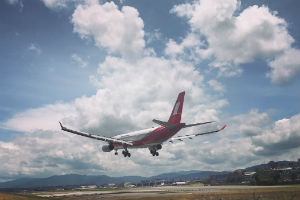Holiday flights already feeling impact of climate change
13 February 2020

Airlines could be forced to cut passenger numbers or fly to fewer destinations in future due to climate change, according to a new study.
Scientists and engineers from four universities in Britain and Greece, including the University of Reading’s Professor Paul Williams, analysed more than six decades’ worth of weather and aircraft data from Greek airports to find out how warmer air and changing winds have affected the ability of aircraft to take off.
They found that aircraft now need longer distances on average to take off due to global warming. Where this is not possible at airports with shorter runways, such as those often found on small island holiday destinations, weight must be reduced by cutting passenger numbers or fuel, or by other means.
Aviation is a rapidly growing contributor of carbon emissions, but this research shows a new way in which climate change is already having an effect on flights. This impact is likely to increase in future if carbon emissions continue to rise.
Professor Paul Williams, atmospheric scientist at the University of Reading and co-author of the study, said: “Warm air and slow winds make it harder for planes to get off the ground, and climate change appears to be making both of these factors more common. Our study is the first to combine measurements of air temperatures and wind speeds to calculate the precise impact on take-offs.
“Reducing passenger numbers clearly results in a financial hit to airlines. Reducing the amount of fuel being carried is an alternative way of shedding weight, but limits the distance that can be travelled. Another possibility is extending runways to allow higher take-off speeds to be reached, but this would mean covering these holiday paradises in even more tarmac.
“None of these are attractive solutions, but we may have to resort to them in future unless climate change is curbed.”
The study, published on 13 February 2020 in the journal Climatic Change, looks at temperature and wind data from 1955 to 2017 at 10 Greek airports, including several popular holiday destinations, analysing take-off conditions for the Airbus A320, a typical medium-scale passenger jet, and the smaller de Havilland DHC8-400.
The team analysed data on temperature, headwind, surface conditions, and runway slope to calculate the take-off distance required and the maximum possible take-off weight for the planes over more than 60 years.
The maximum take-off weight for the A320 decreased by an average of 0.12% per year since it first entered service in 1988, while for the DHC8-400 it was 0.02% per year. The aircraft were also found to climb less quickly after take-off.
At the most affected airport for the A320, its maximum take-off mass reduced by 3,990 kg on average in the 30 years to 2017. This is the equivalent weight of 38 passengers and their luggage or 1300 km (800 miles) worth of fuel.
The take-off distance required for the A320 increased by an average of 2.7 metres (0.15%) per year and for the DHC8-400 by 1.4 metres (0.1%) per year. The required take-off distance for the A320 increased at one airport by 98.6 metres between 1988 and 2017.
Further insight into how climate change is affecting the airline industry could be revealed by repeating the study for other island holiday destinations like the Caribbean or Scottish islands, with the effects likely to be most significant at small airports with only one short runway.
Previous research by Professor Williams has shown that flights worldwide will be affected by increased clear air turbulence in future due to changes to wind shear at cruising altitudes under climate change.
The research was carried out by Cranfield University, University of Reading, University of West London and ATHENA RC in Greece.
Full reference
Gratton, G., Padhra, A., Rapsomanikis, S., Williams, P (2020); 'The impacts of climate change on Greek airports'; Climatic Change; doi: 10.1007/s10584-019-02634-z
